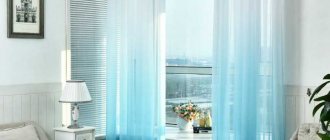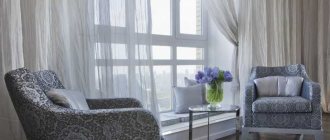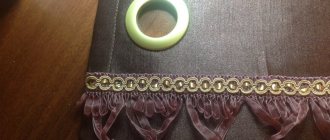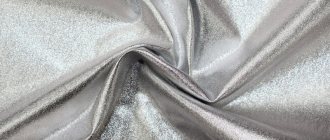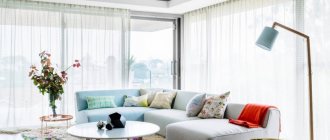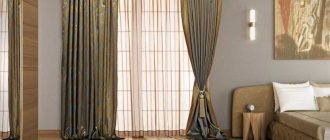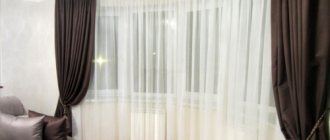Interesting variations of tulle for the hall
Curtains are starting to slowly disappear from room design. In their place comes tulle - transparent or translucent. The unfolded tulle completely illuminates the room with sunlight. And the closed tulle also lets the sun in, but does not allow you to see what is happening in the apartment from the street. In a word, tulle for a hall without curtains is gradually becoming more and more popular solution among designers.
What's leaving the fashion arsenal?
In 2018-1019, plain veils and organza will become irrelevant. Organza at the fair was ignored by all designers without exception. It contradicts the ecological aesthetics of modern housing.
The minimalism of a modern interior requires a brighter window design
A smooth veil is inferior to textured materials in terms of expressiveness and for this reason disappears from fashion displays. As tulle in the living room, the veil lacks understatement, grace and drama - it is too predictable. Minimalism, leading in furniture, requires brighter, eye-catching additions “with character”.
Net
In most cases it is made from synthetic fiber. The result is beautiful, sophisticated and unusual highlights. This look is often done on organza.
It is the retinue that makes the king: tulle for velvet
“It is the retinue that makes the king” – in other words, velvet should be the center of attention. You cannot match it with richly decorated tulle, which will create aesthetic noise around the velvet curtains.
The ideal complement to them will be transparent silk curtains, matching or contrasting - it is up to the designer to decide, based on the concept of decorating the living room.
Sheer curtains will be the perfect complement to velvet
The mesh veil does not withstand proximity to heavy curtains. Of the tulle patterns, only the most unobtrusive and most likely large or geometric ones can be considered. Of course, the patterned tulle option is only for plain velvet.
The most severe test for a designer is to use velvet curtains with a damask pattern in the hall and choose the right tulle for them (photo). But if the project and its implementation prove successful, then this interior will not lose its sharpness and relevance for a long time.
Combination of velvet with damask pattern and matching tulle
Tulle made from linen
This fabric looks sparse, like a worn mesh, and the room looks very cozy and beautiful. An important note is that there are obvious parts of the threads on linen; they diverge in thickness - this makes the fabric more voluminous. And the volume, in turn, gives the fabric fluffiness and warmth.
Linen fabric has a special weave, thanks to which it is laid out in large folds. Tulle made from this fabric fits best into the Provence style.
Tulle drapes
Heavy curtains are also easy to combine with tulle. The word “curtains” literally means “door”, that is, a product that protects against the entry of strangers, but at the same time is capable of closing and opening.
Previously, doorways were often curtained with them, but in modern times this item is placed mainly on windows.
Curtains are often equipped with tiebacks made of various materials; two such curtains are made or just one. Thick fabrics are usually made darker than the tulle itself, but there are exceptions. Multi-colored curtains are selected for a simple plain tulle fabric, while more strict, restrained options are used for patterned fabrics decorated with knots, ruffles, and embroidery.
A voile tulle would be an excellent solution for a hall of this style.
Additions to tulle design
If you decide that tulle and curtains for the hall are not for your home, then there are several more ways to enhance the attractiveness of a room with curtains.
Tie in a bun
Very relevant for large living room windows. Curtains can be gathered into several bundles when more light is needed. At night the bunches are unraveled.
To make it look quite beautiful, you will need to purchase a cornice with a couple of channels for tulle and separately for curtains. Two curtains of different colors are hung on it. It can be pink and beige, blue and white, cream and gray. Using ribbons or special tiebacks, exquisite drapery is created.
Fabric shine
This is achieved with the help of certain threads built into the fiber, creating the impression of a spark, shimmering glare. This effect occurs due to sunlight hitting the fabric.
Note!
Curtains for windows - TOP 120 photo and video examples. Styles and shapes of curtains, their differences. Advantages and disadvantages of window curtainsTulle in the interior: types of tulle, pros and cons of the material. Selection of colors, lengths, quantities and patterns of tulle for different interiors (photo + video)
DIY curtains - instructions for sewing curtains with your own hands. Types of fabrics, colors and patterns for curtains. 120 photos + video reviews
Shining tulle looks very beautiful in a large and bright room, because it brings the window and walls closer together. Without sunlight, with artificial lighting, the flickering effect does not disappear, but only becomes brighter, and in daylight it darkens.
Choosing material for tulle
Today, tulle is made from a variety of materials - chiffon, organza, veil, cambric, etc. Each of them is unique and beautiful in its own way.
In addition, they provide different protection from the sun.
- Jacquard. One of the difficult materials to drape. It looks quite luxurious, due to the fact that the threads from which it is made vary in color and thickness. The finished fabric is embossed and multi-colored. Of course, this material is expensive, but it’s worth it. It will look good in Rococo, Baroque, Oriental or Classic style.
- Chiffon. Despite the fact that this material looks quite expensive, it costs much less than the previous fabric. Thanks to the interweaving of crepe threads, this textile has a complex texture. The fabric is slippery and difficult to process, which must be taken into account when sewing.
- Batiste is a synthetic fabric made using threads twisted together, which perfectly holds the shape given to it. Despite this, the fabric is quite transparent, thin and perfectly transmits sunlight. That is why it is best used with thick curtains.
- Net. A fashionable, sought-after material for decorating a window opening in a living room. This tulle looks quite beautiful without any additional drapery or decoration. The fabric is made of thin synthetic threads, which is why a lot of dust settles in them, which is definitely not suitable for people prone to allergies.
- Organza is a translucent, airy material made from polyester. Occasionally, it also includes silk and viscose, which significantly increases its price. The downside of the product is low breathability, especially when the fabric has many layers - folds. But this material is washed quite easily and dries very quickly.
- Veil. This product is softer than organza, but it is wear-resistant and durable, which is possible due to its density. Dust practically does not settle on it, so there is no need to wash it often. The fabric is perfect for draping, so thanks to this quality you can create all sorts of looks.
- Linen. This material is currently at the top of its popularity. And this is not without reason, because it is environmentally friendly, non-allergenic, since its composition practically does not include synthetic components. But this fabric still has one disadvantage - it wrinkles easily and is quite difficult to iron. Ideally fits into the style - country, Provence, rustic, etc.
When does tulle look best?
Transparent tulle without bulky curtains and curtains looks more than beautiful in the following options:
Small room. Flowy fabrics are great for small spaces because they make the room seem larger. This happens by filling the hall with sunlight. Unlike curtains, which create a clear boundary between the wall and the window, tulle erases these boundaries.
Rooms with little light are usually located on the west, north and north-west sides. These rooms always look very cool; to “warm” them, it is best to hang tulle with the same color scheme.
Certain trends in design: oriental, Provence, minimalistic. Rooms designed in this style should always be illuminated with natural light. In this case, tulle gives the room lightness, grace and sophistication.
Note!
Photos of curtains: design of curtains of different sizes and lengths. Color range, types of materials, patterns and curtain fastenings (photo + video)- Organza tulle: advantages and disadvantages of the material. Varieties of tulle and fastenings. Tips for sewing and installation (photo + video)
- Tulle design - TOP 130 photos + video reviews of tulle designs. Features of choosing fabric, length, quantity and type of tulle
Large rooms in a bulky classic style. Here it is immediately clear that translucent tulle will add sophistication and elegance.
The presence of floor-to-ceiling windows in the room. With such windows you can admire the views from the windows. Tulle will look very advantageous against such a background, creating a shimmering effect. It will look especially beautiful if the room has a balcony.
Minimalism or Baroque
The design of tulle for the hall depends on the size of the room and the window. Large windows in a spacious room will not “tolerate” minimalist drapery, short curtains and curtains. Even if the living room is combined with a loggia and a balcony, which already has heavy curtains.
Small rooms “require” the creation of coziness, and it makes sense not to weigh down the windows of such rooms with thick fabrics and lambrequins. In large halls it makes sense to hang curtains in the Baroque style, decorating them with curtains made of thick and very durable satin.
How to effectively hang tulle
To create a beautiful room using an element such as tulle, there are several popular ideas from designers:
Transparent tulle is hung directly on the rings, the loops are straight - the fabric should develop from floor to ceiling without folds. This is the most versatile option, best used in a minimalist style.
Another great option would be to buy enough fabric at once so that when you hang it, the tulle folds into exquisite folds, resulting in a kind of multi-layered product. It’s easy to guess that such options are suitable for large, bright rooms.
Combination of several colors of fabric on one window. There is a huge range of design options: a transition from dark to light colors, a combination of shades that are completely different from each other.
Note!
- Gray tulle: nuances of using gray tulle in the interior. Suitable gray fabric materials. 150 photos + video examples
- Tulle on a ribbon: advantages and disadvantages of tulle on a ribbon. Types of curtain tapes. Tips for sewing and installation (photo + video)
Small curtains: TOP-180 photos + video of design options for small curtains. Features of small curtains in the interior. Types of curtains, fabrics and colors
But it is very important to seize the moment so that at least one color is combined with the shades of the interior of the room, this will make the interior as harmonious as possible in terms of color relationships.
Combination of different lengths of fabrics. The room will look very impressive if you add long tulle to the floor and hang shorter tulle on top. The resulting layering will look very lush.
Combining fabric textures. An interesting option would be to mix smooth and light fabrics with rough ones, plain tulle and bright embroidery, exquisite lace and light silk.
For a classic style, such a decoration option as cords for picking up tulle is suitable.
You can try using lambrequins. This creates the effect of sophistication and luxury. But in order not to overdo it and not to make it cheaply, the ideal option would be to make lambrequins from a plain, smooth fabric.
If you plan tulle with curtains
In this case, beautiful tulle must be purchased along with the curtains. As a rule, the curtain is several tones lighter than the main color of the curtains. Also, most housewives choose simple white options, or sophisticated ones: mesh tulle, curtains with complex embroidery, thread curtains.
Such options are considered by designers to be new tulle products and are considered fashionable in 2021. Tulle plays the role of a background if the curtains in the living room are rich and very bright, or impress with a unique print.
In other cases, it is worth choosing interesting and even universal curtains, combined with curtains of different textures, types and colors.
Photo of tulle in the hall
Fashion trends
Fashion designers are constantly developing new ideas. Regarding tulle for the 2021 hall, they agreed that it was better to abandon curtains altogether. This is not a bedroom or a nursery where you sleep, and it is necessary to darken the room. And in the hall it is quite acceptable to limit yourself to tulle, which will look light and airy.
If window decoration without curtains seems unfinished to you, decorate the tulle with lambrequins. And tulle with photo printing itself looks complete and does not need additional elements. If you choose lace tulle, the room will immediately be transformed beyond recognition.
Refusal of curtains will add volume, light and air to the hall. So residents of high floors should take this advice into account.
If you take into account all the nuances in choosing tulle, the curtains will highlight the interior of the room and make the room much more attractive and comfortable.
